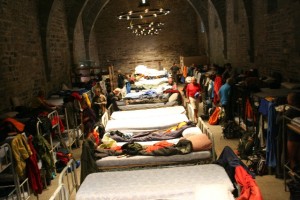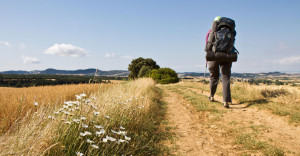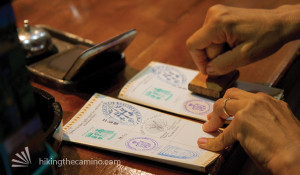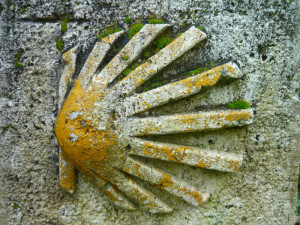The Camino De Santiago
I discovered the Camino de Santiago from the 2011 film “The Way”. It’s a heart felt story set on the Camino de Santiago. I’ve felt the calling of the Camino ever since!
.
The Camino de Santiago or the Way of St. James is a spiritual journey that pilgrims of all faiths and backgrounds have traversed for over a thousand years. The pilgrimage originally began at one’s doorstep, though modern trekkers today would find that rather difficult, particularly American pilgrims needing to cross the Atlantic. While there are a number of established routes leading to Santiago from all directions, the most popular is the Camino Frances, which crosses the Pyrenees Mountains along the Spanish-French border starting in St. Jean Pied de Port. This Camino route covers 500 miles that traverses an idyllic northern Spanish countryside.
,

By following the yellow painted arrows marking the road, a pilgrim can expect to walk 12-15 miles a day to reach the next town for the night. At this pace, a pilgrim can reach the Cathedral de Santiago in 6 to 8 weeks time to attend the Pilgrim’s Mass held at noon each day. Some take more time, others less. Some choose to travel by bike, and some have done the Camino on horseback. Along the way travelers encounter albergues, refugios and casa rurals that cater specifically to the thousands of pilgrims of all ages that take this journey each year, immersing themselves in the local food, culture and history dedicated to this experience.
done the Camino on horseback. Along the way travelers encounter albergues, refugios and casa rurals that cater specifically to the thousands of pilgrims of all ages that take this journey each year, immersing themselves in the local food, culture and history dedicated to this experience.
 Pilgrims walk the Camino for various reasons. Some to seek penance, others enlightenment, and still others for a sense of adventure, yet all progress toward the Cathedral in Santiago where it is believed the remains of the apostle St. James are held. Most pilgrims choose to carry a scallop shell with them to symbolize their journey in honor of St. James. According to legend, scallop shells are said the have covered St. James’ body after it was found on the shores of the Galician coast. Another, perhaps more useful symbol is a walking stick to aid a weary pilgrim on his or her journey.
Pilgrims walk the Camino for various reasons. Some to seek penance, others enlightenment, and still others for a sense of adventure, yet all progress toward the Cathedral in Santiago where it is believed the remains of the apostle St. James are held. Most pilgrims choose to carry a scallop shell with them to symbolize their journey in honor of St. James. According to legend, scallop shells are said the have covered St. James’ body after it was found on the shores of the Galician coast. Another, perhaps more useful symbol is a walking stick to aid a weary pilgrim on his or her journey.
 Most pilgrims also carry a document called the credencial, purchased for a few euros from a Spanish tourist agency, a church on the route or from their church back home. The credencial is a pass which gives access to inexpensive, sometimes free, overnight accommodation in refugios along the trail. Also known as the “pilgrim’s passport”, the credencial is stamped with the official St. James stamp of each town or refugio at which the pilgrim has stayed. It provides walking pilgrims with a record of where they ate or slept, but also serves as proof to the Pilgrim’s Office in Santiago that the journey is accomplished according to an official route. The credencial is available at refugios, tourist offices, some local parish houses, and outside Spain, through the national St. James organisation of that country. The stamped credencial is also necessary if the pilgrim wants to obtain a compostela, a certificate of completion of the pilgrimage.
Most pilgrims also carry a document called the credencial, purchased for a few euros from a Spanish tourist agency, a church on the route or from their church back home. The credencial is a pass which gives access to inexpensive, sometimes free, overnight accommodation in refugios along the trail. Also known as the “pilgrim’s passport”, the credencial is stamped with the official St. James stamp of each town or refugio at which the pilgrim has stayed. It provides walking pilgrims with a record of where they ate or slept, but also serves as proof to the Pilgrim’s Office in Santiago that the journey is accomplished according to an official route. The credencial is available at refugios, tourist offices, some local parish houses, and outside Spain, through the national St. James organisation of that country. The stamped credencial is also necessary if the pilgrim wants to obtain a compostela, a certificate of completion of the pilgrimage.
 Regardless of whether a pilgrim’s journey begins for religious, spiritual or cultural reasons, the meditative nature of the Camino offers the perfect landscape in which to dedicate contemplation. Pilgrims follow the path amidst the villages, towns, rivers, mountains and fertile valleys that have changed the lives of millions of pilgrims who walked before them.
Regardless of whether a pilgrim’s journey begins for religious, spiritual or cultural reasons, the meditative nature of the Camino offers the perfect landscape in which to dedicate contemplation. Pilgrims follow the path amidst the villages, towns, rivers, mountains and fertile valleys that have changed the lives of millions of pilgrims who walked before them.